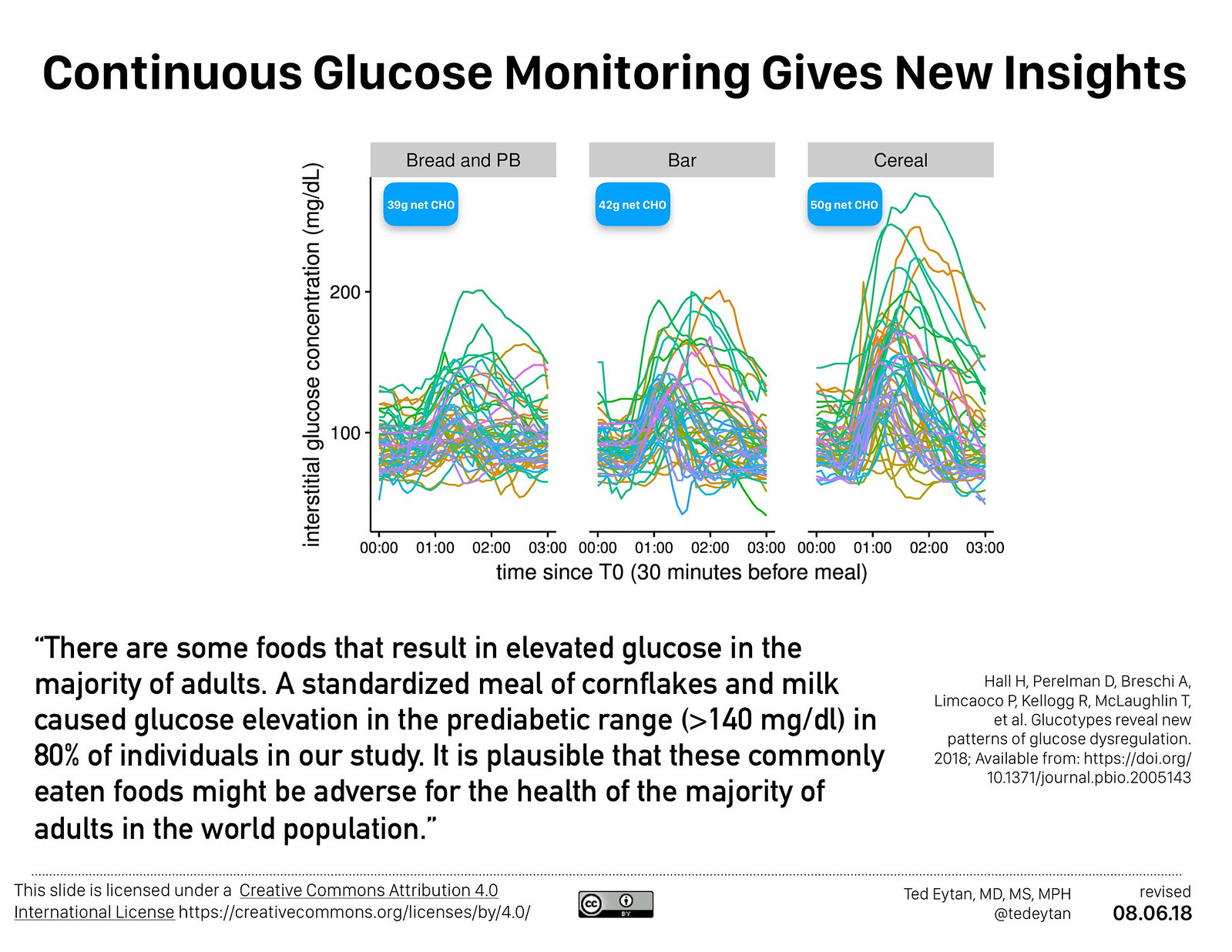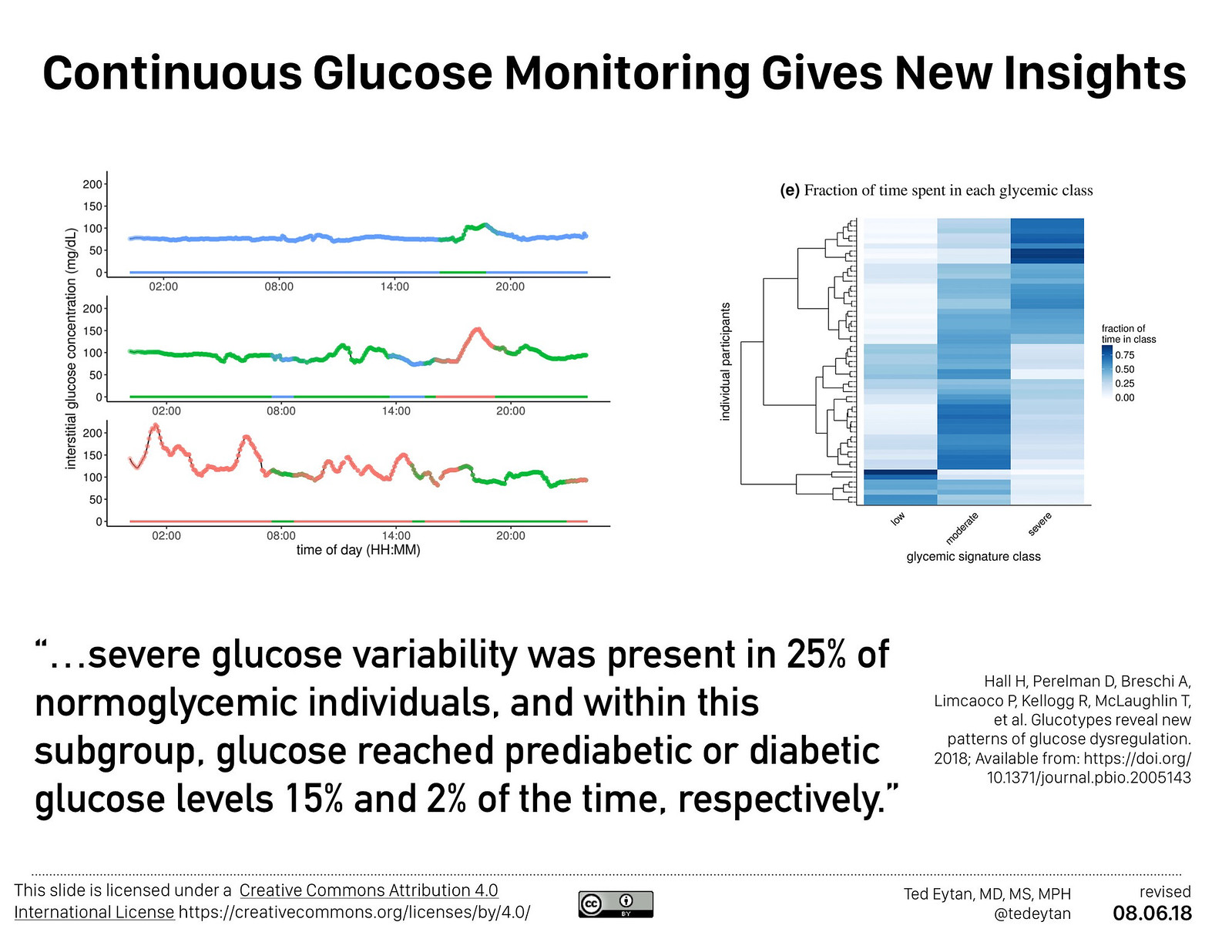
This was bound to happen, and h/t Zoe Harcombe (@ZoeHarcombe) to alerting us to this new study looking at the measurements coming from continuous glucose monitors in a 30-57 subjects all various states of metabolic health.
New technology shows early signs of metabolic unhealth
In the slide above, the challenges to glucose regulation can be seen for three different meals. The one with the greatest problems is the cereal with milk and raisins. This meal is incidentally the lowest calories, lowest fat of the three meals.
There are some foods that result in elevated glucose in the majority of adults. A standardized meal of cornflakes and milk caused glucose elevation in the prediabetic range (>140 mg/dl) in 80% of individuals in our study. It is plausible that these commonly eaten foods might be adverse for the health of the majority of adults in the world population.Hall H, Perelman D, Breschi A, Limcaoco P, Kellogg R, McLaughlin T, et al. Glucotypes reveal new patterns of glucose dysregulation. 2018; Available from: doi.org/10.1371/journal.pbio.2005143 (used under Creative Commons license)
and

…severe glucose variability was present in 25% of normoglycemic individuals, and within this subgroup, glucose reached prediabetic or diabetic glucose levels 15% and 2% of the time, respectively.Hall H, Perelman D, Breschi A, Limcaoco P, Kellogg R, McLaughlin T, et al. Glucotypes reveal new patterns of glucose dysregulation. 2018; Available from: doi.org/10.1371/journal.pbio.2005143 (used under Creative Commons license)
As a reminder, In 1990, 2.52% of the U.S. population had diabetes. It’s now 9.4%, 12% of adults. It’s estimated that 25% of adults will have diabetes in the US by 2030, 33% by 2050. Prediabetes converts to type 2 diabetes with an annual rate of approximately 10%. 55% of Californians now have some level of insulin resistance.
Curious statement about the American Diabetes Association – favoring a low carb approach?
The authors made this statement which most people in this space would find curious (i.e. incorrect)
Zeevi and colleagues found that the postmeal glucose response to identical foods varies across individuals [11]. This is an important finding, given that the American Diabetes Association (ADA) dietary recommendations are based mainly on reduction of carbohydrate content…Hall H, Perelman D, Breschi A, Limcaoco P, Kellogg R, McLaughlin T, et al. Glucotypes reveal new patterns of glucose dysregulation. 2018; Available from: doi.org/10.1371/journal.pbio.2005143 (used under Creative Commons license)
As Mark Cucuzzella, MD, a family medicine specialist at West Virginia University School of Medicine points out, there’s no mention of lowering carbohydrates whatsoever on this website:
DoIHavePrediabetes.org | Reverse Prediabetes
The same goes for the current (2018) ADA Standards of Care.
Here’s what is mentioned on the website linked above:
Believe it or not, salads CAN be delicious. Look up interesting ways to prepare them and other vegetables, and aim to eat at least one at dinner every night.
Low-fat doesn’t have to be low on flavor. So try to cook in these ways: roast, broil, grill, steam or bake — instead of deep-frying or pan-frying.
Reading food labels is so important. The more you know about what goes into your food, the better decisions you’ll be able to make. Also, try and cut down on foods with saturated fat or trans-fat, and hydrogenated fat or partially hydrogenated fat. Check labels to help you make healthy choices.
Choose foods with less sodium than your usual choices.
There’s an infographic present on the site, however, none of the steps mentioned for reversing prediabetes mentions lowering carbohydrates. Actually, the steps recommend eating the type of meal above that spike most people’s serum glucose.
Here’s Mark’s presentation, it’s worth a listen in terms of doing things to improve the health of people and communities we serve. H/T Jeffry Gerber, MD (@JeffreyGerberMD)
Reference
Hall H, Perelman D, Breschi A, Limcaoco P, Kellogg R, McLaughlin T, et al. Glucotypes reveal new patterns of glucose dysregulation. 2018; Available from: doi.org/10.1371/journal.pbio.2005143 (used under Creative Commons license)